![]()
![]()
![]()
Use LEFT and RIGHT arrow keys to navigate between flashcards;
Use UP and DOWN arrow keys to flip the card;
H to show hint;
A reads text to speech;
28 Cards in this Set
- Front
- Back
|
Hand Innervation |
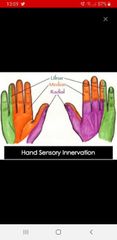
|
|
|
To 3 |

To 4 |
|
|
To 5 |
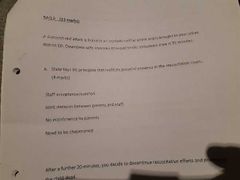
Mm |
|
|
Weber and Rinnes test |
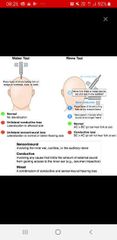
|
|
|
Weber 2 |
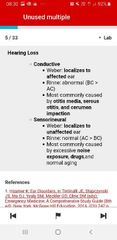
|
|
|
Kidney stones sizes |
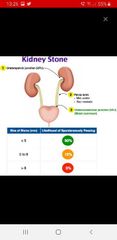
|
|
|
Optic Neuritis |
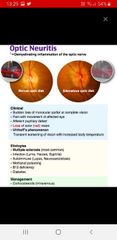
|
|
|
Hyphaema |
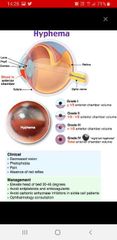
|
|
|
Risk factors for Elder Abuse |
1) Cognitive impairment 2) Physical impairment- unable to defend self 3) Dependence on carer 4) Social isolation 5) Chronic illness 6) Social stressors |
|
|
Factors influencing severity of Electrical injury |
Voltage level > 1000v are high risk injuries
Current level > 2 amps causes burns and > 10amps causes asystole
Current type- AC likely to cause VF
Pathway of current- determines the type and severity of the injury. # Vertical more dangerous. # Horizontal more likely to affect the heart.
Duration - longer duration = more severe injuries. |
|
|
INDICATIONS FOR telemetry in Electrical injury |
High voltage > 1000 volts.
LOC.
Seizures.
ECG changes or documented arrythmia. Hx of IHD.
Burns.
Previous cardiac dx esp arrythmia. |
|
|
Causes of NAGMA |
Small bowel fistulae. Excess chloride. RTA Diarrhoea Addison's |
|
|
PDCA circle |
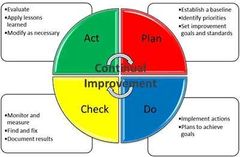
|
|
|
Quality improvement in ED |
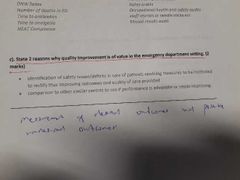
|
|
|
Risk factors for CENTRAL RETINAL VEIN OCCLUSION |
HTN Trauma Vasculitis Alcohol Glaucoma Hypercoagulable states Diabetes |
|
|
Episcleritis vs scleritis |
Episcleritis is painless. |
|
|
GUIDELINES PREPARATION |
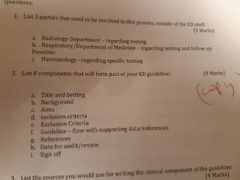
|
|
|
Hyponatremia from emn |

|
|
|
Shortcut for Fi02 (713-Fio2) |
0.21 = 150 0.28 = 200 0.4 = 300 |
|
|
ACEM policy care of the elderly in ED |
-ED funding and staffing levels should reflect the increased medical complexity and nursing dependency of elderly patients -use validated screening tools to identify vulnerable elderly patients at risk so that appropriate discharge planning begins as early as possible -education programs should ensure all ED staff are able to recognise possible elder abuse as well as age specific presentations of medical and surgical condition -elderly patients should have good access to a call bell, meals and pressure area care |
|
|
Frailty |
•a state of poor physiological & functional reserve -lack of resilience to stressors -cumulative decline in multiple physiologic systems •associated with -increased age -disproportionate reduction in health/functional status -poor recovery in response to stressors. •frequent clinical presentations of frailty -falls -delirium -functional disability -non specific:-extreme fatigue-weight loss-frequent infections
•“frailty is a practical, unifying notion in the care of elderly patients that directs attention away from organ-specific diagnoses (i.e. disease) towards a more holistic viewpoint of the patient and their predicament”
|
|
|
Serum sickness causes |
Antivenom Immunoglobulin Streptokinase Other drugs - cefaclor - quinidine, quinine - hydralazine - procainamide |
|
|
CRVO RF |
Diabetes HTN Glaucoma Hyperviscosity Atherosclerosis |
|
|
HBO in DCS |
Reduction in bubble size, increasing outward nitrogen diffusion. Reduction of endothelial inflammation. Relief of ischemia and HYPOXIA. |
|
|
Adverse effects of hyperbaric oxygen |
Muscle twitching Vertigo Visual disturbance Apprehension Nausea Confusion Dizziness (Includes vertigo symptoms) |
|
|
AMS - like a hang over LAKE LOUISE AMS SCORE |
1) Headache 2) GIT symptoms 3) Fatigue or weakness 4) Dizziness/ light headed 5) Difficulty sleeping Score >3 is diagnostic of AMS |
|
|
Angiodema treatment |
Icatabant 30mg s/c
C1E -inhibitor (Berinert) - 20u/kg Txa FFP Danazol 200mg Aminocrapoic acid 8g |
|
|
Causes of C1 esterase inhibitor deficiency --> Angiodema |
SLE Gammopathy Lympho-proliferative disorders DIC ECMO Septic shock |

